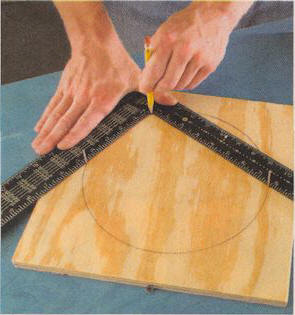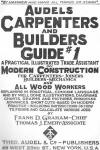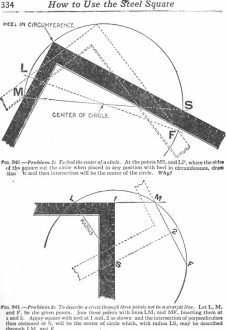|
"Squaring
the circle" may as yet be an unattainable goal for even the best mathematicians,
but the November 2012 edition of The Family Handyman magazine had a tip for how to use
a square (of the framing type) and two nails to draw a circle. The author
comments, "Don't ask us why this process works; all we know is that it does." Out of curiosity, I dug out my father's
old Audels Carpenters and Builders Guide (printed in 1945) to see if it
described the method and if it did, was there an explanation offered. It did,
and he did. Read on...
Make a circle with a square
"Here's a tip for laying out small circles or parts of circles. Tack two nails
to set the diameter you want, then rotate a framing square against the nails while
you hold a pencil in the corner of the square. You might need to rub a little wax
or some other lubricant on the bottom of the square so it slides easily.
Don't ask us why this process works; all we
know is that it does."
 They're either very honest or they don't think
the average reader would understand the explanation. They're either very honest or they don't think
the average reader would understand the explanation.
The Pythagorean theorem is the key, of course, for explaining the reason. For
any right triangle:
 a2 + b2 = c2,
a2 + b2 = c2,
where 'a' and 'b' are the lengths of the two perpendicular sides, and 'c' is
the length of the hypotenuse. The same equation also happens to be (not by coincidence)
the equation for a circle of radius 'c,' with the center at point (0,0). So, it
stands to reason that if all of the parameters are met (three intersecting straight
sides with a right angle between two of them), then the locus of points of all permissible
value pairs (a,b) will result in a circle. It does not matter whether your value
of 'c' represents a radius or a diameter. The hypotenuse will always be the length
between the two nails and sides 'a' and 'b' will always be the distance between
each nail and the 90° vertex. QED
   Out of curiosity, I dug out my father's
old Audels Carpenters and Builders Guide (printed in 1945) to see if it described
the method and if it did, was there an explanation offered. The author did show
how to draw a circle with a framing square, and even described how to find the diameter
of a circle whose area is equal to the sum of the areas of two given circles (not
sure why that would be need by a carpenter). However, an explicit reason for why
it all works out is never given. Out of curiosity, I dug out my father's
old Audels Carpenters and Builders Guide (printed in 1945) to see if it described
the method and if it did, was there an explanation offered. The author did show
how to draw a circle with a framing square, and even described how to find the diameter
of a circle whose area is equal to the sum of the areas of two given circles (not
sure why that would be need by a carpenter). However, an explicit reason for why
it all works out is never given.
Here is what is included in the manual:
Outer heel method:
Drive brads at points L, F, extremities of the given diameter. With pencil held
at the outer heel M, slide square around with its sides in contact with L, and F,
then with the pencil held at M, describe a semi-circle.
Inner heel method:
Obviously if the pencil be held at S, it will be better guided, than at M. In
this method, the distance L'F' should be taken to equal diameter, the inner edges
of the square sliding on the tacks-the same edges (in either case) that guide the
pencil.
 At the ends of the diameter LF (fig. 939)
drive brads. Place the outer edges of the square against the nails and hold a lead
pencil at the outer heel M, any semi-circle can be described as indicated. At the ends of the diameter LF (fig. 939)
drive brads. Place the outer edges of the square against the nails and hold a lead
pencil at the outer heel M, any semi-circle can be described as indicated.
This is the outer heel method. but a better guide for the pencil is obtained
by the inner heel method also shown in the figure.
FIG. 940 - Problem 2: To find the center of a circle. At the points MS, and LF,
where the sides of the square cut the circle when placed in any position with heel
in circumference, draw diameter and then intersection will be the center of the
circle. Why?
FIG. 941 - Problem 3: To describe a circle through three points not in a straight
line. Let L, M, and F, be the given points. Join these points with lines LM, and
MF, bisecting them at 1 and 2. Apply square with heel at 1 and 2 as shown and the
intersection of perpendiculars thus obtained at S, will be the center of circle
which, with radius LS, may be described through LM and F.
To find the center of a circle.
Lay the square on the circle so that its outer heel lies in the circumference.
Mark the intersections of the body and tongue with the circumference. A line connecting
these two points is a diameter and by drawing another diameter (obtained in the
same way) the intersection of the two diameters is the center of the circle as shown
in fig. 940.
To describe a circle through three points not in a straight line.
 Joint points with straight lines;
bisect these lines and at the points of bisection erect perpendiculars with the
square. The intersection of these perpendiculars is the center from which a circle
may be described through the three points as in fig. 941. Joint points with straight lines;
bisect these lines and at the points of bisection erect perpendiculars with the
square. The intersection of these perpendiculars is the center from which a circle
may be described through the three points as in fig. 941.
To find the diameter of a circle whose area is equal to the sum of the
areas of two given circles.
Let O, and H, be the given circles (drawn with diameters LR, and RF at right
angles). Suppose diameter of O, be 3 inches, and diameter of H, 4 inches. Then points
L, F, at these distances from the heel of the square will be 5 inches apart as conveniently
measured with a two-foot rule as shown. This distance LF, or 5 inches, is diameter
of the required circle. Proof: LF2 = LR2 + RF2,
that is 52 = 32 + 42 or 25 = 9+16. (this is as
close as they come to explaining the phenomenon, but not really).
Posted September 1, 2021
(updated from original post on 12/25/2012)
|








 "
" They're either very honest or they don't think
the average reader would understand the explanation.
They're either very honest or they don't think
the average reader would understand the explanation.  a2 + b2 = c2,
a2 + b2 = c2,




